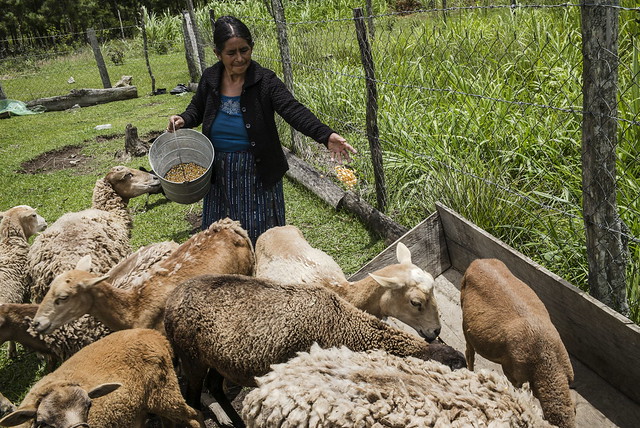
Mexico’s Guatemalan refugees: where are they now?
How Guatemalan refugees found peace and prosperity through farming
Emilia Felipe José, a Guatemalan refugee and farmer, making tortillas in her home. ©Alex Webb/Magnum Photos for FAO
28/03/2018
Perched on gently rolling hills, San Lorenzo village in southern Mexico has been home to some 50 refugee families who fled Guatemala’s civil war.
The Mexican Commission for Aid to Refugees (COMAR) estimates that over 45,000 people fled to Mexico in the ‘80s, mainly from villages and cantons of Guatemala’s Huehuetenango and Quetzaltenango regions.
Nicolás Gómez Domingo, an indigenous chuj, was 11 when he crossed the border with his parents, four sisters and brothers. His wife, Emilia Felipe José, an indigenous Acatenca, was eight.


Emilia and her husband, Nicolás Gómez Domingo, working in their greenhouse (right) and feeding their pigs. ©Alex Webb/Magnum Photos for FAO
Those were gruesome times. Times neither Emilia nor Nicolás can forget.
“We were camping in paddocks . Some of our relatives died because we were attacked even on the way…We slept in the trees, under the rain,” recalls Emilia, her dark eyes in constant motion, running this way and that as if filled with the same fear she must have felt 35 years ago.
The first years in Mexico were full of uncertainty, continues Nicolás.
“We stayed in Santiago El Vértice first. We didn’t know what was going to happen, if we were going to stay. We were waiting for the situation to be solved so that we could return. But it wasn’t like that. We grew up in Santiago El Vértice, and later moved to San Lorenzo.”
This is where Emilia and Nicolás met. Both refugees, both learning to fit in. For years, they feared their traditional way of dressing, their language might give them away. They didn’t want to be found out and sent back to Guatemala.

Farmers working in a maize field framed with avocado plants in the village of San Lorenzo. The village is populated by refugees who fled Guatemala’s civil war in the ‘80s. ©Alex Webb/Magnum Photos for FAO
From refugees to thriving farmers
A change happened when, in 2005, they were told they could participate in government programmes.
With the support of the Mexican Government, the Diocese of San Cristóbal and the UN Refugee Agency (UNHCR), the families of Emilia and Nicolás, along with 22 other Guatemalan families, bought 78 hectares of land.
Then, in 2011, they joined the “Strategic Food Security Project” (PESA), a project implemented by the government with support from FAO.
The project aims to develop Mexico’s poorest and most marginalized rural communities. San Lorenzo fitted both criteria.

Related links
The project enabled Nicolás and Emilia to start rearing chickens, pigs, rabbits; grow vegetables and fruits; and be part of farmers’ cooperatives to better plan and sell their products.
“I have never imagined that I would get to work with the other women. Our lives have changed ,” says Emilia.
Emilia and Nicolás do most of the farm work together. But she looks more after the chickens and pigs, and tends to the avocado and beans. Nicolás is up early morning, every day, to take care of the lambs and cows, before joining his wife and the others in the corn and beans fields.
The farmers practice “milpa” agriculture, a form of agriculture common in Mesoamerica, which entails inter-cropping a variety of plants, such as corn, beans and avocadoes.
Their eldest son, Matías, who had migrated to the US in search for work, returned home once the project started, and joined his parents.
"There is no need to leave for work anymore. We can stay and build our country,” says Matías.
Find out more about FAO’s work in Mexico.

